Welcome to the landscape photography blog by Chuck Derus. Thanks for looking and for your comments!
Serendipity


One more class would fill my schedule. It was spring quarter of my freshman year in college. There weren’t many courses open because my alphabetical group was the last to choose.
South American Geography 101 was still open and seemed better than the alternatives. Little did I know my selection would ignite a lifelong passion to visit the continent based on my professor’s mesmerizing photographs.
My dream finally came true in 2014 when I visited Chile and Argentina. I photographed Patagonia’s Torres del Paine (PIE-neh) national park. Torres is the Spanish word for tower and Paine means blue in the native Tehuelche language. I also photographed Fitz Roy.
TripAdvisor elected the park as the Eighth Wonder of the World, and it deserves the honor. Established in 1957, it encompasses breathtaking Andean mountains, forests, steppes, glaciers, lakes, rivers, and fjords. My youngest daughter and son-in-law visited Patagonia a few years ago and thoroughly enjoyed the experience.
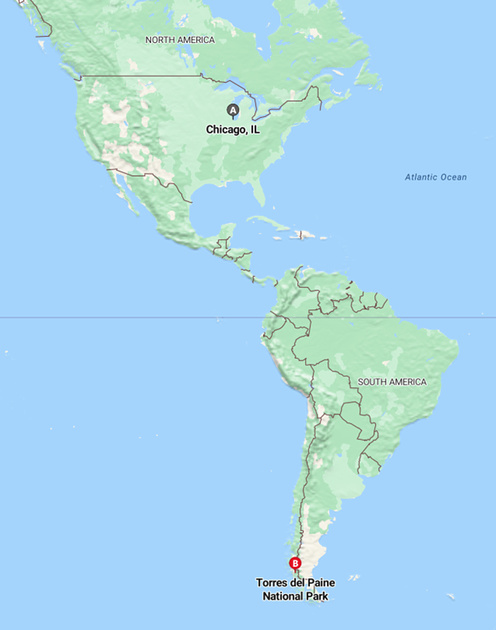

The park averages around 252,000 visitors a year, of which 54% are international. It’s famous for strong winds that peak in summer (November to January in the southern hemisphere). Expect to be blown off your feet on occasion.
Second Chances
Since it’s 6,487 miles from Chicago, I thought it was going to be my one and only visit. But a second chance presented itself!
During the pandemic lockdown, one of my photography workshops was cancelled. Rather than accept a refund, I opted to roll over the deposit for the opportunity to revisit Patagonia in 2024.
I recently returned from that trip. It was just as magical as the first trip, with the added adventure of four days on a boat in the Patagonian fjords.
Before departing, I wondered if my photography skills had improved over the decade. Was Maya Angelou correct? “I did then what I knew how to do. Now that I know better, I do better.”
The Shot
Lake Pehoé (hidden lake in Tehuelche) provides the iconic view of Paine Grande (left) and the Cuernos (horn) del Paine (right). Photographing well before sunrise was the key change from a decade earlier.
Thirty to forty-five minutes before sunrise, reflected sunlight from below the horizon bathes the landscape in beautiful soft light without any harsh, distracting shadows. It appears to be sunrise, but with much more pleasing light.
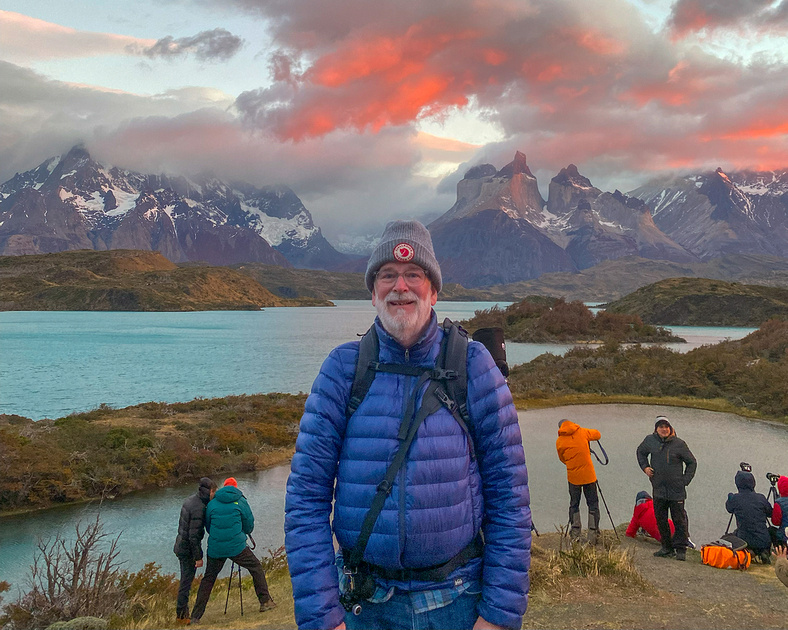

Packed up and leaving as a hoard of photographers arrives after the best light is over.
By the time the sun started touching the top of the peaks a half hour later, the site was overrun by photographers. The direct light started producing harsh shadows and dull colors. It was time to pack up and began my 52-hour journey back to Chicago.
Thanks for looking,
Chuck Derus
Beauty and Photography
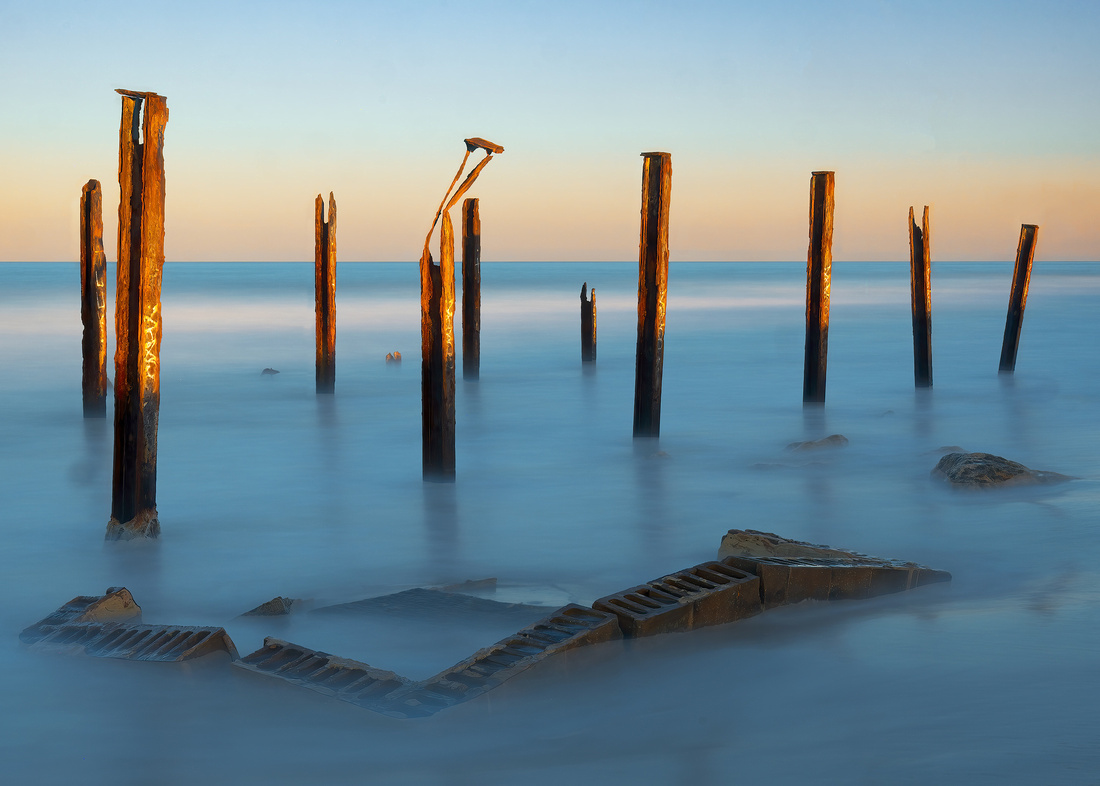

We’re surrounded by beauty. But sometimes, the camera fails to capture that arresting scene. Our eyes see the world differently than the camera.
For example, walking through a forest is an alluring experience. Tree trunks, branches, and leaves dance in the light, combining to form lovely images that change with every step.
But what happens when you stop walking and take a picture of the forest? Oftentimes, the photograph is disappointing. The grandeur has been reduced to a chaotic, confusing, jumble of elements by the camera.
I once spent two days in the Hoh Rainforest in Washington State. The sights were mesmerizing. But I emerged with only one good photograph. The hundreds of others appeared to be a feeble attempt to document an explosion in a green spaghetti factory!
Other times, beauty is inescapable, even to the camera. For example, you can stand anywhere on the breathtaking Zabriskie Point Overlook in Death Valley National Park and take the same pleasing image of Manly Beacon.
What About Ugly?
You might think that “ugly” subjects never make arresting photographs. For example, who gets excited at the prospect of images of mud?
Yet images of mud can be delightful.
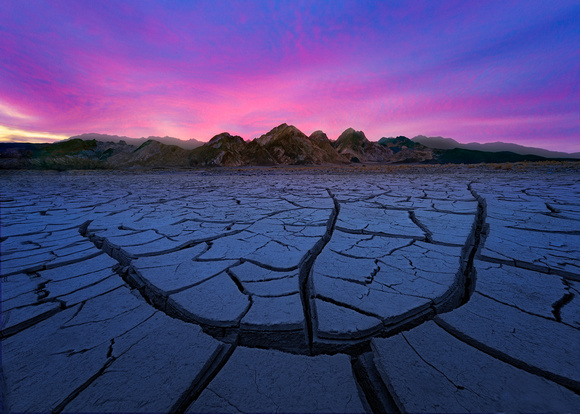

Mud cracks in Death Valley National Park
The Shot
Two years ago, I spent several days on Florida beaches photographing the simple beauty of waves. But one evening, the wind was calm, and no good waves appeared.
I could have given up and left for dinner. But I decided to seek out an alternative subject instead.
An assemblage of rusty steel H-beams and broken concrete block was just down the beach. Most people would classify it as junk and want it removed. Could ugly be transformed by the camera?
It had potential. First, I looked for an angle to capture the diagonals. Next, I carefully positioned the camera to avoid any distracting overlapping of the beams. Finally, I used a long shutter speed to simplify and smooth out the water, further reducing distractions.
The sunset light warmed up parts of the rusty orange beams, contrasting nicely with the blues of the sky and ocean. Everything just seemed to come together beautifully in this satisfying image.
Thanks for looking,
Chuck Derus
The Haldi Cones
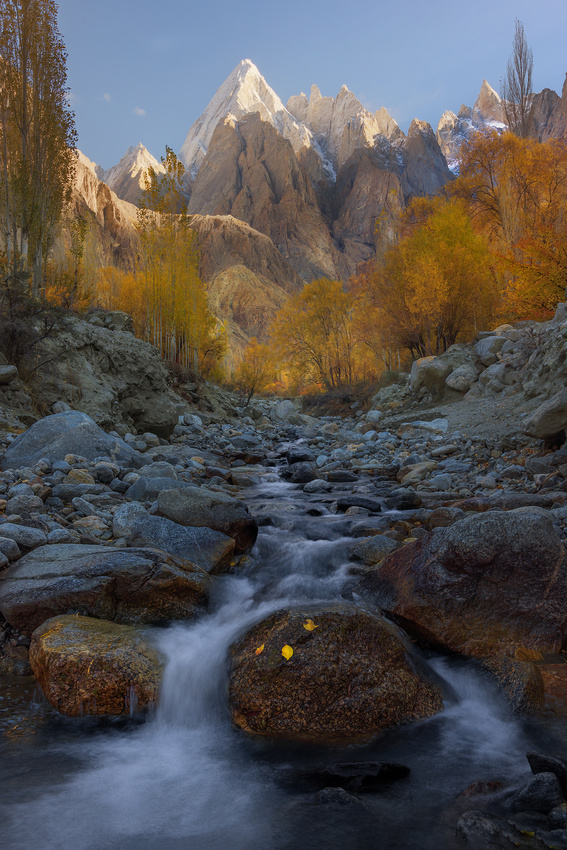

The Cones fuse beauty and grandeur to create a breathtaking amalgam. Granite peaks soar majestically to the heavens, adorned with ragged ridges, sharp spires, and towering cliffs. Most of these peaks have never been climbed because of the rugged terrain, technical difficulties, and limited access.
The Cones are situated near Haldi village in the Ghanche district of Gilgit Baltistan in Pakistan. The landscape surrounding Haldi village is mesmerizing, Verdant valleys, glistening streams, and snow-capped peaks create an idyllic setting.
Along with the captivating Cones, the area offers other attractions. The Saling Valley, Yochung Valley, Machulu Valley, and Haldi Village itself are exceptional sightseeing locations. However, the Machulu Village viewpoint truly shines among these options.
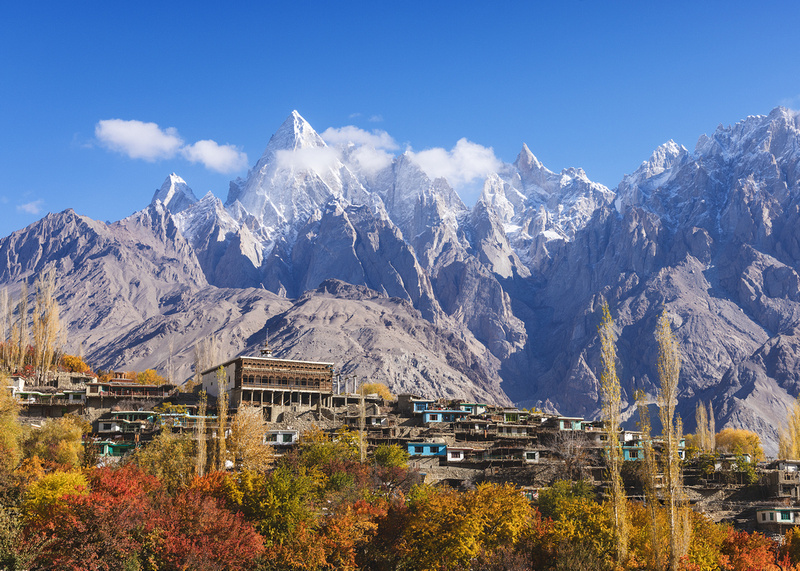

The Haldi Cones from Machulu Village
Working the Area
As usual, we arrived early on the morning of November 4 and scouted for locations along the stream running through Haldi village. The villagers were curious and several of them struck up conversations with our group of photographers.
We kept crisscrossing a stream evaluating compositions leading to the Cones. In some spots, it was tricky crossing the rocky stream. Only a single footbridge graced the stream. And in Pakistan, bridges are shared by people, vehicles, and livestock.
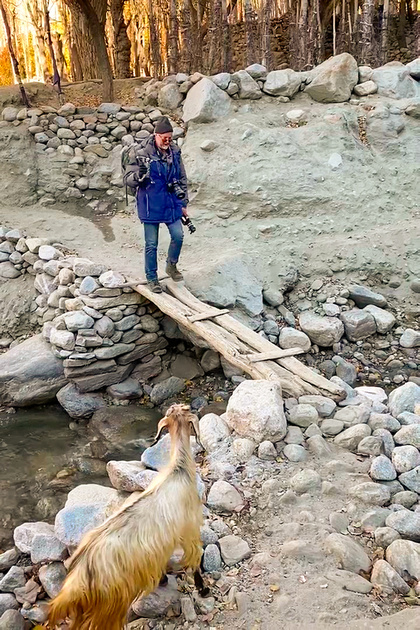

This goat thought the better of it and turned around when he spotted friend and fellow photographer Jon Christofersen starting to cross.
The Shot
After finding a composition, we waited for the light. If the sun was too low, the mountain would be unappealing. And if it was too high, numerous harsh shadows on the mountain and in the valley would be chaotic and distracting.
To play it safe, we took photographs every five minutes or so for about a half hour. After that, it was back to town for breakfast and a warm cup of coffee.
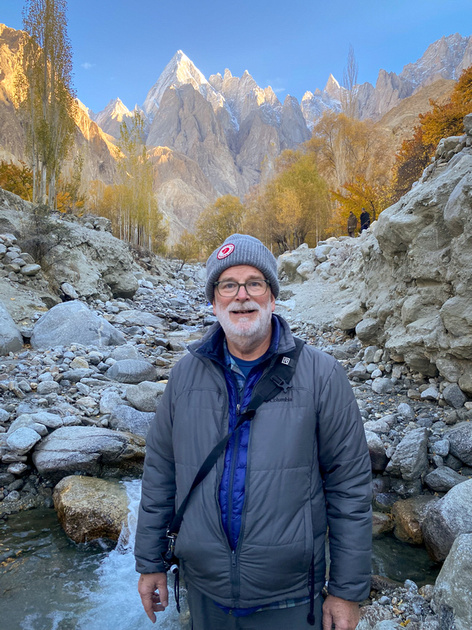

I’ll be in the field for the next two weeks, so the next Friday Photo will be on April 19.
Thanks for looking,
Chuck Derus
Mountains


Picturesque is the word to describe northern Pakistan. And the Saling Valley is filled with vivid images.
Nestled in the Ghanche District of Khaplu in Gilgit-Baltistan, the Valley is a destination waiting to be discovered. It also serves as a gateway to the enchanting Hushe Valley.
The markhor goat is the national animal of Pakistan and is abundantly present in the Valley. The word mārkhor (مارخور), meaning "snake-eater," comes from both Pashto and classical Persian languages. It stems from the snake-like form of the male markhor's horns, possibly leading ancient peoples to associate them with snakes.


From science.org
Most people in the Valley grow wheat, potatoes, tomatoes, and other vegetables. Small herds of livestock add milk and meat to the diet. We found everyone to be hospitable and friendly.
The Shot
We awoke well before dawn in nearby Khaplu on November 3 and then drove east. After a short while, we turned north on a connecting road to the town of Saling. Before we reached town, we stopped, parked, and hiked about a mile east looking for a foreground to complement the distant mountains.
The pre-dawn light beautifully embraced the distant peaks. We had colorful bushes in the foreground and a pair of trees created a complimentary frame-within-a-frame for our composition. Once the sun came up, harsh shadow lines created so many distracting shadows that we put away our cameras.
After that, it was a short hike back to our vehicles. Luckily, breakfast and a hot cup of coffee was not far away in Khaplu.
Thanks for looking,
Chuck Derus
Greener Than Green River Soda!


Greener Than Green River Soda!
Is it a celebration of Irish heritage or an excuse to party? It’s probably both. Parties, bar crawls, and parades are held worldwide celebrating St. Patrick’s Day.
The history of St. Patrick’s Day in Chicago dates back more than 175 years. Now a longstanding tradition, Chicago’s Irish parade was first held in 1843 becoming an official city event in the 1950s. Along with the downtown festivities, Chicago’s proud Irish heritage is also on full display in multiple neighborhoods.
Since 1962, Chicago has dyed the east branch of the Chicago River neon green in a now iconic annual celebration. Thousands of people line the Riverwalk and crowd Chicago’s bridges to glimpse the phenomenon. It’s typically held at 10 a.m. the Saturday before St. Patrick’s Day and is followed by the downtown parade.
Crews from the Chicago Plumbers Union Local 130 create a spellbinding spectacle spreading the dye from boats in honor of St. Patrick’s Day. The best views of the newly colored river are from Upper Wacker Drive between Columbus and Fairbanks.
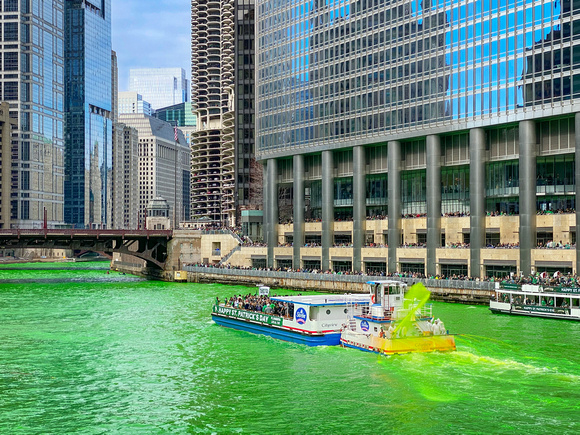

iPhone shot from the Michigan Avenue bridge.
The event started thanks to serendipity. In 1961 Stephen Bailey, business manager of the Chicago Plumbers Local 130, was approached by a plumber.
His normally white coveralls were heavily stained (or dyed) the perfect shade of Irish green. When Bailey asked how his coveralls got this way, he learned that the dye used to detect leaks into the river colored the fabric that special color.
That's when Mr. Bailey bellowed, “Call the mayor…we will dye the Chicago River green!” That first 1962 river dyeing turned the waters green for nearly a month. Currently, the color only lasts for a few hours. The union’s environmentally friendly dye formula remains a closely held secret.
The Shot
I had never witnessed the event, so fellow photographer Jon Christofersen and I headed downtown last Saturday. In retrospect, we should have left earlier as the traffic and crowds made for slow going.
After trying in vain to find a place to launch our drones in the Columbus/Fairbanks area, we hiked west to Wolf Point at the convergence of the north, south, and east branches of the Chicago River. It was easy to launch drones from there, but signal interference from the buildings limited our range.
I enjoyed this view the most. After the drone landed, we made our way back to our parked car. I should have brought my regular camera as the St. Patrick’s Day revelers were as colorful as the river!
Thanks for looking,
Chuck Derus